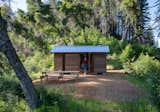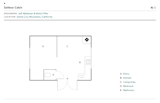Construction Diary: After a Devastating Fire, a Couple Start Over With a $17K DIY Cabin
As if the global pandemic wasn’t enough, 2020 brought San Franciscans Jeff Waldman and Molly Fiffer another major life challenge. That was the year a forest fire ravaged their 10-acre property in the Santa Cruz Mountains, destroying the cabin and camp-like retreat they had spent the last several years building by hand with the help of friends and family. "For the first couple of years, there wasn’t a lot to be done with the property," recalls Jeff. "It was pretty devastated by the fire."
After slowly cleaning up the land and seeing the forest spring back to life with new growth, Jeff and Molly started to think about starting over. "It wasn’t about rebuilding, because the word ‘rebuild’ felt like a reclamation of what was," says Jeff. "That felt impossible—it was a time and a place that we couldn’t really get back to."
| $185 Foundation | $1,758 Floor Joists, Plywood | $7,105 Salvaged Redwood |
| $948 Roofing | $509 Hardware, Misc. Building Supplies | $120 Plumbing |
| $77 Kitchen & Bath Fixtures | $92 Lighting | $5,400 Sliding windows, French doors |
| $670 Glass for Nine windows | $550 Metalwork | |
| Grand Total: $17,414 | ||
Eventually, Jeff and Molly decided to start again. They devised a plan to construct a simple cabin on the site of their original build, using primarily lumber from fire-damaged trees on site that they chainsaw milled with the help of friends. The second time around, the duo found themselves bringing an entirely new energy to the build.
Grieving and Starting Over
Jeff: After the fire, we would occasionally spend time on the property, but it just wasn't the same. Things slowly started improving over the years as we did our cleanup, and about a year and a half ago we built a micro A-frame out there with some friends just to have some kind of shelter. Soon, however, I was itching for a larger project.
When the fire came through, it killed a lot of trees but didn’t consume them. These standing, dead trees were eyesores and safety hazards, so we started chipping away at them, literally. We would rent chippers and run the trees through, and the bigger ones we knew we had to mill. We thought, ‘If we’re going to mill these, what might we use the lumber for?"
We had been kicking around the idea of a small cabin build on the site where the previous cabin stood, but it was hard for me to get started because I think the property just didn’t feel like a safe space anymore after the fire. I didn’t immediately get hit with a sense of loss after the fire, but when it came time to start building, it hit me.
So we just kept milling the trees and when friends would ask, ‘Is this wood for a cabin?’, I wouldn’t really admit it. Eventually, after Molly put together a calendar of our friends’ availability to help on site, it started building up some steam to actually construct a thing.
Evolution
Jeff: Neither Molly nor I were interested in an earnest rebuild of what was there before. We knew we wanted to do projects out there and enjoy the property, but having been burned in the past (literally), we wanted to put a limited amount of emotional and financial investment into the new cabin. While the first build had a lot of whimsy as this vision of an adult summer camp, this time around we didn’t want to pour months of work and money into it.
The original vision for this new cabin was actually something much simpler than what it ended up being—we thought it could just be a simple alpine hut. We knew we wanted a dry sink, a propane cooktop, a wood stove, and no electrical, and we stuck to that. But once we got going, Molly advocated for adding a second layer of siding and making it a truly weatherproof building.
We put up a decent roof, and instead of polycarbonate windows like we originally planned, we decided to make proper windows ourselves by hand. I had never made a window before this, and we did nine for this cabin. That’s probably the detail I’m most happy about, because it pushed the boundaries of my woodworking capabilities. I’m personally a lot more proud of this cabin in that respect.
New Life
Jeff: One of the most fun things has been seeing the regrowth of the property. When newer friends visit us, they tell us it doesn’t even look like there’s been a fire. The tree bark is still blackened, but the fresh undergrowth is vibrant and lush. In many ways, we haven’t ever seen so much life on that property. Now, you have to watch where you step when you walk around because there are so many banana slugs everywhere.
It’s really interesting to watch a place change like that. This cabin and the property has been an evolution for us, too. What Molly and I have developed here is more than just a set of structures, it’s a sense of identity. When we bought this property, we didn’t know anything about building. A lot of our skills and interests have emerged here, and for me, it’s turned into a real calling.
Even though we know the property might burn again as wildfires become ever-increasing in the West, I don’t regret building this new cabin. It’s about accepting the fact that tomorrow is not really promised for any of us, or for our buildings. The opportunities to be had from experiencing a thing like making this cabin (and the first one) are worth a tremendous amount. It’s worth the risk of loss.
Jeff and Molly offer plans, blueprints, and models of everything they’ve built on their property over the years via their company, Elevated Spaces.
More Construction Diary stories:
In the Mojave Desert, a First-Time Builder Takes On a Tricky Prefab Home
It Took a Decade, But Their Experimental, DIY Home Was Worth the Wait
A Maine Designer Builds His Family’s Home Completely by Hand
Project Details:
Builders: Jeff Waldman and Molly Fiffer, Elevated Spaces / @elevatedspaces
Published
Last Updated
Stay up to Date on the Latest in Tiny Homes
Discover small spaces filled with big ideas—from clever storage solutions to shape-shifting rooms.
















